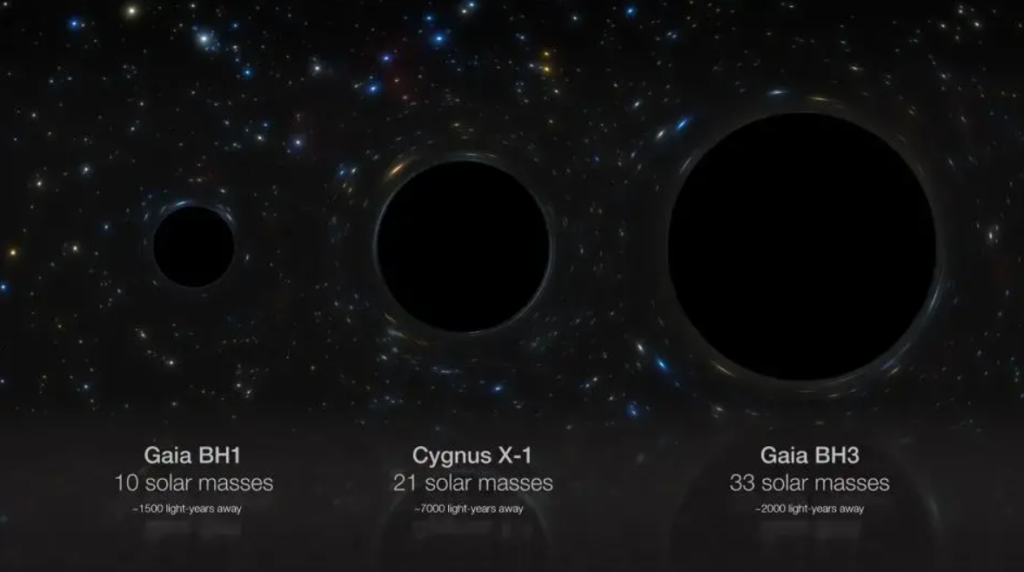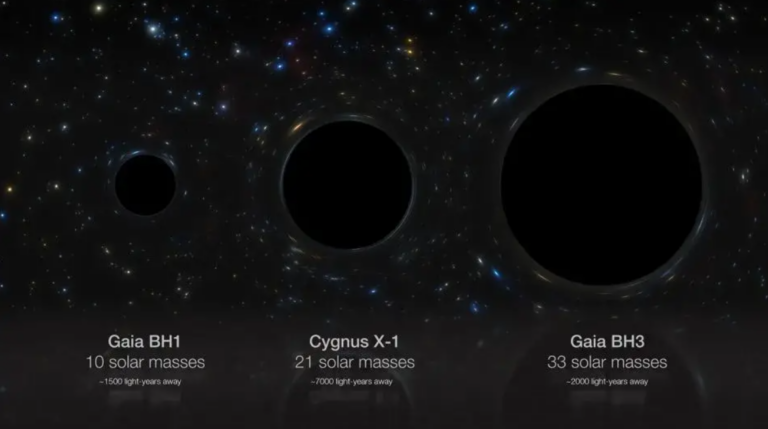Astronomers have recently pinpointed the most massive stellar black hole in the Milky Way galaxy. This breakthrough occurred when they detected an unusual wobble in the surrounding space.
Known as Gaia BH3, this massive entity has a mass nearly 33 times that of our sun. Located about 1,926 light-years away in the Aquila constellation, it is the second-closest black hole to Earth, after Gaia BH1, which is approximately 1,500 light-years away and has a mass nearly ten times that of our sun.
The discovery of Gaia BH3 was made while analyzing data from the European Space Agency’s Gaia space telescope. Initially unexpected, the peculiar motion caused by Gaia BH3’s gravitational pull on a nearby companion caught the researchers’ attention.
Many dormant black holes do not have nearby companions, making them difficult to detect as they do not emit light. However, some stellar black holes attract material from companion stars, emitting bright X-rays that can be observed through telescopes.
The interaction between an aging giant star in the Aquila constellation and a dormant black hole confirmed the presence of Gaia BH3, marking the third such discovery by Gaia.
To verify Gaia BH3’s mass, astronomers used the European Southern Observatory’s Very Large Telescope and other ground-based observatories in Chile’s Atacama Desert. Their study also shed light on the formation of such massive black holes. These findings were detailed in the journal Astronomy & Astrophysics.
Study lead author Pasquale Panuzzo, an astronomer at the Observatoire de Paris, expressed astonishment at the finding, noting that the presence of a high-mass black hole nearby, undetected until now, was unexpected. This type of discovery is a rare occurrence in one’s research career.
Pasquale Panuzzo, the main researcher of the study and an astronomer at the Observatoire de Paris, was taken aback by the findings. He mentioned, “The presence of a high-mass black hole in close proximity, previously unnoticed, came as a surprise to everyone. Such a discovery is a rare occurrence in one’s research career.”
The formation of supermassive black holes such as Sagittarius A* in the center of the Milky Way, which exceed Gaia BH3’s mass by millions of times, is still not well comprehended. Unlike stellar black holes that originate from the demise of massive stars, supermassive black holes are believed to form from the collapse of massive cosmic clouds. Therefore, Gaia BH3 stands out as the most massive stellar black hole in the galaxy, resulting from the death of a massive star.
Gaia BH3’s emergence has dethroned Cygnus X-1 as the largest stellar black hole in the Milky Way, which previously held this prestigious title. With a mass 21 times greater than that of the sun, Cygnus X-1 has now been surpassed by Gaia BH3. This remarkable discovery places Gaia BH3 in the league of celestial objects found in far-off galaxies, underscoring its immense importance in the field of astrophysics.

The formation of supermassive black holes such as Sagittarius A* in the center of the Milky Way, which exceed Gaia BH3’s mass by millions of times, is still not well comprehended. Unlike stellar black holes that originate from the demise of massive stars, supermassive black holes are believed to form from the collapse of massive cosmic clouds. Therefore, Gaia BH3 stands out as the most massive stellar black hole in the galaxy, resulting from the death of a massive star.
Researchers suggest that stellar black holes such as Gaia BH3 are created through the collapse of metal-deficient stars, which are composed mainly of hydrogen and helium. These stars shed less mass as they age, leading to an excess of material during the collapse process, which could ultimately give rise to the development of massive black holes.
Significantly, the discovery of Gaia BH3 offers concrete proof of the connection between high-mass black holes and stars with low metal content. This connection is further supported by the metal-poor composition of the companion object in its orbit.
The trajectory of Gaia BH3’s companion star implies that it originated from a small galaxy that merged with the Milky Way more than 8 billion years ago. This unique orbit suggests that the star formed within the first 2 billion years after the universe’s creation, in contrast to the majority of stars in the Milky Way’s galactic disk.
The research team expects that their discoveries will empower fellow astronomers to delve deeper into Gaia BH3, revealing additional mysteries prior to the complete Gaia data unveiling set for late 2025.
Carole Mundell, the director of science at the European Space Agency, commended the profound influence of Gaia on the field of astronomy. She expressed her admiration, stating, “The remarkable impact of Gaia on astronomy and astrophysics is truly awe-inspiring. Its findings have surpassed the initial objective of creating an exceptionally accurate, multi-dimensional map of over a billion stars within our Milky Way galaxy.”
Do not forget to share your opinion with us to provide you with the best posts !




0 Comments